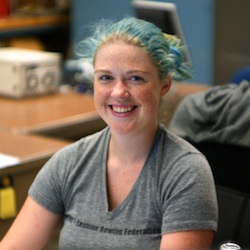- Plasma Physics -

Ph.D. and Eng.Sc.D. Programs on HBT-EP
Students join the HBT-EP group after after completing the M.S. program in applied physics, specializing in one applied physics field. Successful completion of an approved 30-point program of study is required in addition to successful completion of a written qualifying examination taken after two semesters of graduate study. An oral examination, taken within one year after the written qualifying examination, and a thesis proposal examination, taken within two years after the written qualifying examination, are required of all doctoral candidates.
The program builds a foundation in the science and application of plasma physics and features a specialty in the high-temperature plasma physics needed for controlled fusion energy. Besides a sound basic training in relevant areas of applied physics, students develop expertise in experimental, theoretical, and computational plasma physics. This instruction provides the background needed to conduct research in Columbia University’s Plasma Research Laboratory and in other national plasma research facilities. Since its inception in 1960, the program at Columbia has granted more than 110 doctoral degrees with many of our graduates playing leading roles in all phases of plasma physics, including, in particular, the worldwide program to develop controlled fusion energy.

Doctoral students typically join the HBT-EP group after passing qualifying exams at the end of their first year, but may take 2-3 research credits in the lab during one or both of their first two semesters. Early projects are usually introductory, involving work on analysis projects or assisting with the development, assembly, or installation of diagnostics.
After joining the group, a doctoral student may take on the development or operation of a particular diagnostic or another machine upgrade, or pursue a modeling or theory project, and may change research avenues until settling on a thesis project in agreement with their advisor. Experimental thesis projects are intensively hands-on, and students take on significant responsibility for the design and implementation of new systems with guidance from faculty and staff, as well as assisting with maintenance and repairs as needed. Most students learn to set up and operate all but the most sensitive of HBT-EP's systems and diagnostics.
Projects
| Magnetic | Optical | Feedback | Other |
|---|---|---|---|
| Ferritic Wall | Soft X-Ray | Data Acquisition | Hall Probe |
| Poloidal Sensors | Thomson Scattering | Power Amplifiers | Bias Probe |
| Toroidal Sensors | Fast Camera | CPCI | Mach/Float Probe |
| Rogowski Coils | D-Alpha | Signal Amps | Rotation |
Comments
As a 1st year PhD student, the HBT-EP experiment and research group is offering me a great opportunity to study plasma and fusion technologies while furthering my own education and allowing me to contribute my own ideas. One of the things that attracted me most to the HBT-EP lab is its strong record of turning out talented and well respected scientists of the fusion community, and I look forward to soon being counted among their numbers.
HBT-EP is a great student-run tokamak experiment. As the theoretical/computational member of the team, I analyze how MHD instabilities behave under a variety of configurations that are testable in our lab. With its unique adjustable walls, plasma shaping and rotation, the HBT-EP device is ideal for exploring the limits of a tokamak.
The program here is very comprehensive and a lot of fun. I get the first hand experience in running the tokamak, from as detail as measuring data, routing signal all the way to physics modelling and algorithm design. Daily work involves understanding the physics, analytical derivations and implementing my thoughts into codes. Besides, it is always cool to contribute to the fusion community.
I chose the Columbia University Plasma Physics doctoral program in particular because of the uniquely hands-on nature of the HBT-EP experiment, where working directly with the machine and taking a leading role in design and implementation are all strongly encouraged. I believe the best way to learn how to set up and run experiments is to have experience in every stage of the process, which is how the HBT-EP group works.